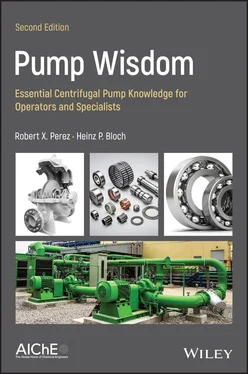The rotating impeller ( Figure 1.3) is usually constructed with swept‐back vanes, and the fluid is accelerated from the rotating impeller to the stationary passages into the surrounding casing.
In this manner, kinetic energy is added to the fluid stream (also called pumpage) as it enters the impeller's suction eye (A on Figure 1.3), travels through the impeller, and is then flung outward toward the impeller's periphery. After the fluid exits the impeller, it gradually decelerates to a much lower velocity in the stationary casing, called a volute casing, where the fluid stream's kinetic energy is converted into pressure energy (also called pressure head). The combination of the pump suction (inlet) pressure and the additional pressure head generated by the impeller creates a final pump discharge pressure that is higher than the suction pressure [3].
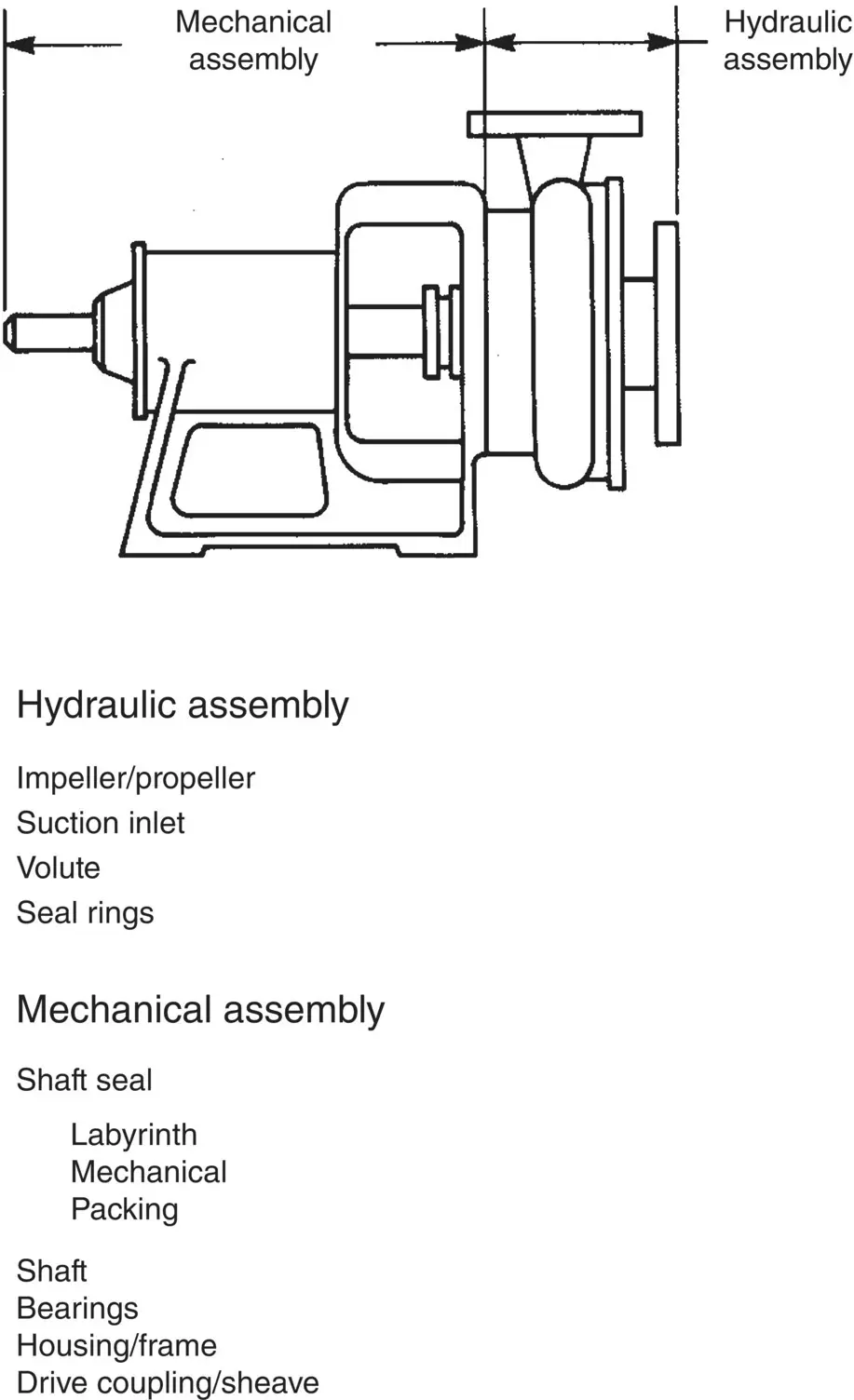
Figure 1.1 Principal components of an elementary process pump.
Source: SKF USA, Inc. [1].
Pump Performance: Head and Flow
Pump performance is always described in terms of head H produced at a given flow capability Q , and hydraulic efficiency η attained at any particular intersection of H and Q . Head is customarily plotted on the vertical scale or vertical axis (the left of the two y ‐axes) of Figure 1.4; it is expressed in feet (or meters). Hydraulic efficiency is often plotted on another vertical scale, the right of the two vertical scales, i.e. the y ‐axis in this generalized plot.
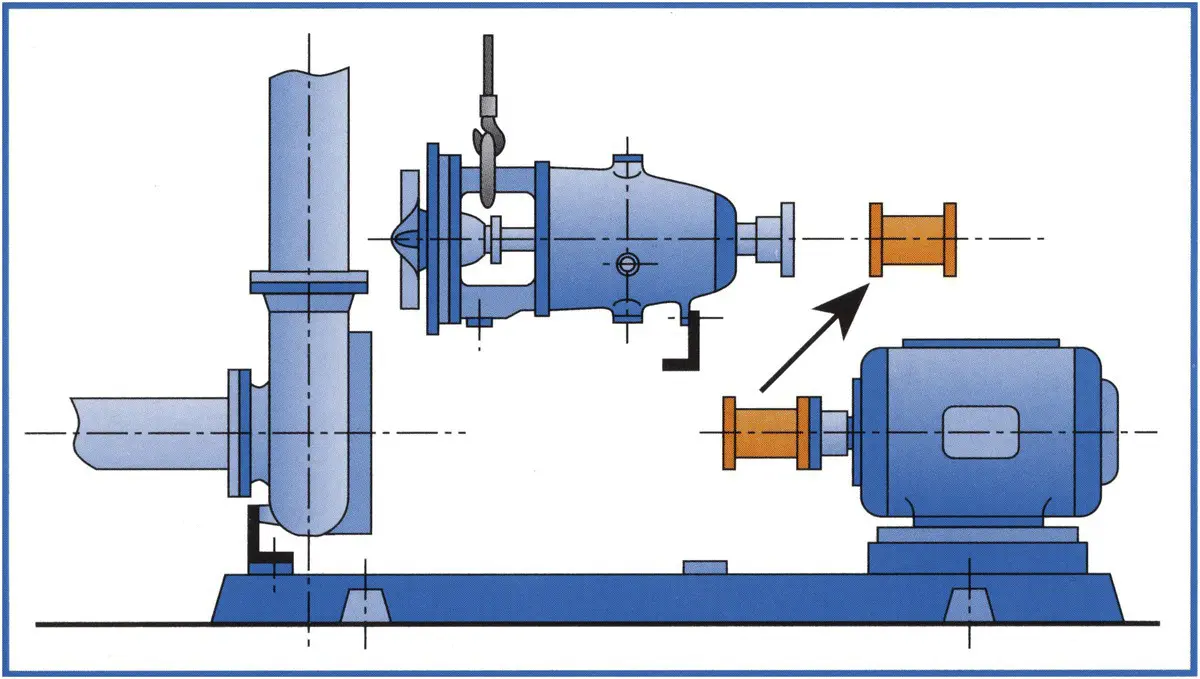
Figure 1.2 Typical process pump with suction flow entering horizontally and vertically oriented discharge pipe leaving the casing tangentially.
Source: Emile Egger & Cie. [2].
Head is related to the difference between discharge pressure and suction pressure at the respective pump nozzles. Head is a simple concept, but this is where consideration of the impeller tip speed is important. The higher the shaft rpm and the larger the impeller diameter, the higher will be the impeller tip speed – actually its peripheral velocity.
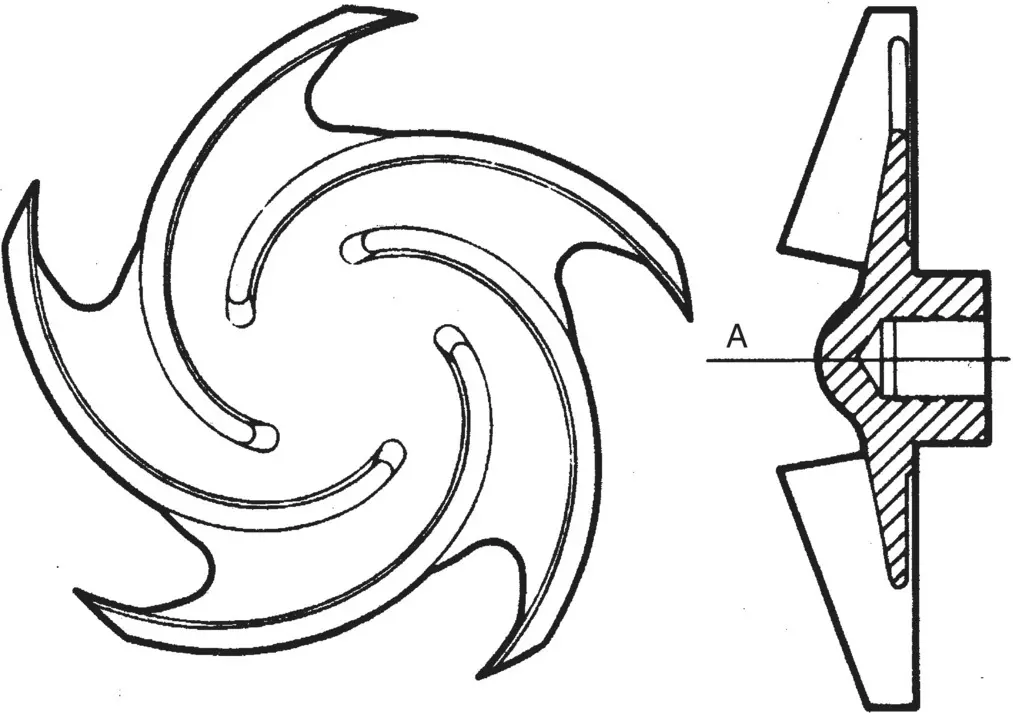
Figure 1.3 A semiopen impeller with five vanes. As shown, the impeller is configured for counterclockwise rotation about a centerline “A.”
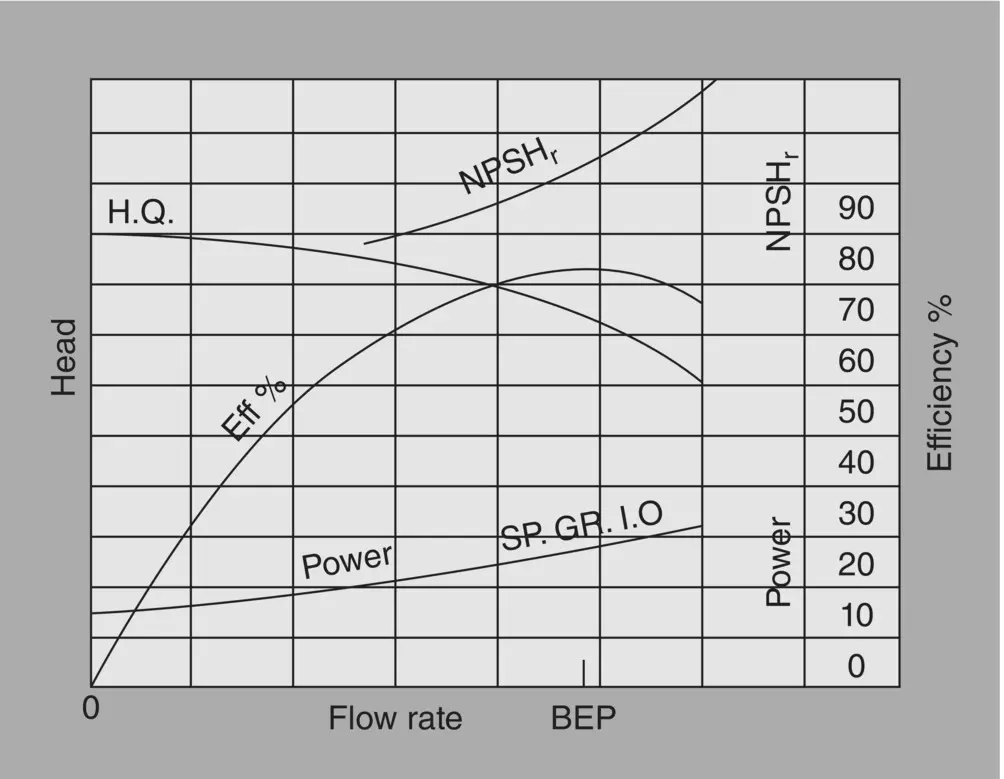
Figure 1.4 Typical “ H – Q ” performance curves are sloped as shown here. The best efficiency point (BEP) is marked with a small triangle; power and other parameters are often displayed on the same plot.
The concept of head can be visualized by thinking of a vertical pipe bolted to the outlet (the discharge nozzle) of a pump. In this imaginary pipe, a column of fluid would rise to a height “ H ”. If the vertical pipe would be attached to the discharge nozzle of a pump with higher impeller tip speed, the fluid would rise to a greater height “ H +”. It is important to note that the height of a column of liquid, H or H +, is a function only of the impeller tip speed. The specific gravity of the liquid affects power demand but does not influence either H or H +. However, the resulting discharge pressure does depend on the liquid density (specific gravity or Sp.G.). For water (with an Sp.G. of 1.0), an H of 2.31 ft equals 1 psi (pound‐per‐square‐inch), while for alcohol, which might have a Sp.G. of 0.5, a column height or head H of 4.62 ft equals 1 psi. So if a certain fluid had an Sp.G. of 1.28, a column height (head H ) of 2.31/1.28 = 1.8 ft would equal a pressure of 1 psi.
For reasons of material strength and reasonably priced metallurgy, one usually limits the head per stage to about 700 ft. This is a fairly important rule‐of‐thumb limit to remember. When too many similar rule‐of‐thumb limits combine, one cannot expect pump reliability to be at its highest. As an example, say a particular impeller‐to‐shaft fit is to have 0.0002–0.0015 in. clearance on average size impeller hubs. With a clearance fit of 0.0015 in., one might anticipate a somewhat greater failure risk if this upper limit were found on an impeller operating with maximum allowable diameter.
On Figure 1.4, the point of zero flow (where the curve intersects the y ‐axis) is called the shut‐off point. The point at which operating efficiency is at a peak is called the best efficiency point, or BEP. Head rise from BEP to shut‐off is often chosen around 10–15% of differential head. This choice makes it easy to modulate pump flow by adjusting control valve open area based on monitoring pressure. Pumps “operate on their curves” and knowledge of what pressure relates to what flow allows technicians to program control loops.
The generalized depictions in Figure 1.4also contain a curve labeled NPSH r, which stands for Net Positive Suction Head required. This is the head of liquid that must exist at the edge of the inlet vanes of an impeller to allow liquid transport without causing undue vaporization. It is a function of impeller geometry and size and is determined by factory testing. NPSH rcan range from a few feet to a three‐digit number. At all times, the head of liquid available at the impeller inlet (NPSH a) must exceed the required NPSH r.
The rate of flow through a pump is labeled Q (gpm) and is plotted on the horizontal axis (the x ‐scale). Note that for a given speed and for every value of head H we read off on the y ‐axis, there is a corresponding value of Q on the x ‐axis. This plotted relationship is expressed as “the pump is running on its curve.” Pump H – Q curves are plotted to commence at zero flow and highest head. Process pumps need a continually rising curve inclination and a curve with a hump somewhere along its inclined line will not serve the reliability‐focused user. Operation at zero flow is not allowed and, if over perhaps a minute's duration, could cause temperature rise and internal recirculation effects that might destroy most pumps.
But remember that this curve is valid only for this particular impeller pattern, geometry, size, and operation at the speed indicated by the manufacturer or entity that produced the curve. Curve steepness or inclination has to do with the number of vanes in that impeller; curve steepness is also affected by the angle each vane makes relative to the impeller hub. In general, curve shape is verified by physical testing at the manufacturer's facility. Once the entire pump is installed in the field, it can be re‐tested periodically by the owner–purchaser for degradation and wear progression. Power draw may have been affected by seals and couplings that differ from the ones used on the manufacturer's test stand. Occasionally, high efficiencies are alluded to in a manufacturer's literature when bearing, seal, and coupling losses are not included in the vendor's test reports.
Читать дальше
